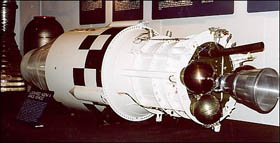Agena

Agena A.
Agena was a versatile space vehicle developed by the United States Air Force. It served as an upper stage on a variety of boosters including Thor, Atlas, and Titan IIIB. It could carry a satellite into a precise orbit then launch it back toward Earth for recovery, carry experiments into orbit and radio data back to Earth, or place small space probes on interplanetary paths. One version of the Agena served as a target for docking experiments during the Gemini Project.
Development of the Agena began in 1956. On 28 February 1959, a Thor-Agena placed Discoverer 1 into the first polar orbit ever achieved by a man-made object. An Agena A carried Discoverer 14 into orbit on 18 August, 1960, and sent it back to Earth 27 hours later to become the first satellite recovered in midair after reentry from space. The Agena had primary and secondary propulsion systems. The main engine had a thrust of about 70,000 newtons (N), while the secondary was used for small orbital adjustments. Both engines used liquid propellants and (from the Agena B on) could be restarted in orbit.


